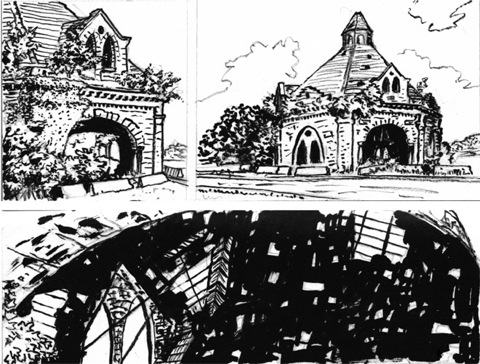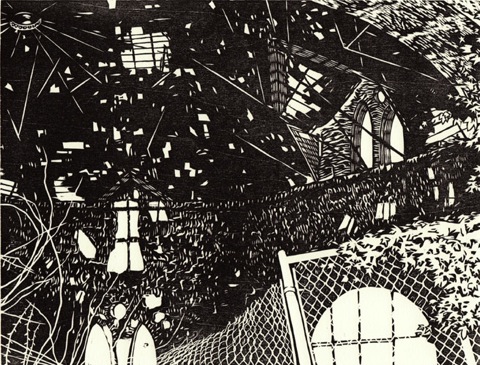After Darwin #3
03/07/11 11:28 Filed in: After Darwin | Pellinore Press
The young Charles Darwin, long before he was made famous for his ideas in On the Origin of Species, could be said to have been drifting. After studying medicine and finding it unpleasant, Darwin studied at Cambridge for three years at the urging of his father in supposed preparation for clerical ordination, but was far more interested in natural history. After a brief respite, he was to return to Cambridge for some final study.
At this time he was recommended by a teacher at Cambridge for a position on board H.M.S. Beagle, which, under Captain Robert FitzRoy, was to conduct a survey voyage of distant parts as it circled the world. The exact nature of Darwin’s position is debatable, though it includes one or both of the following parts: as geologist, and/or as gentlemen companion to the captain (someone of his social class to share meals with, etc.). The ship already had a naturalist, but he quit after just four months and Darwin took his place.
In The Voyage of the Beagle Darwin is not offering evidence to support a view, but is collecting data, making observations, and sharing anecdotes. Of course, what he observes is quite likely crucial to the subsequent development of his theory of “descent with modification.”
It was difficult for me to decide what to do for this print at first. Certainly, amazing scenes, geologic events, animals, and people are described on nearly every page. But, all that he describes is far away and it seemed ridiculous to use vicarious sources/photographs to draw from. What kept striking me were his experiences. So, whatever I did had to be within my experience. I began to examine the recurrent themes in The Voyage, rather than particular animals or places. Darwin observes and surmises on the way things change with time, particularly on a geologic scale, so I decided to create something from my own experience that reflects the passage of time.
I find it interesting that there is more “nature” in the city of Baltimore than one might assume, and that its incursion is fairly rapid if lots and structures are neglected: overgrown yards, rotting porches, crumbling walls, plants growing from gutters where a little organic material has collected. Although these are conditions of disuse, apathy, or neglect, there is a beauty to them. Perhaps there is something hopeful to seeing the vegetation unfurl from a seemingly hostile environment, or the tendency for time to imbue things with character.
I decided to use the Clifton Park Valve House to represent these ideas. Located on Saint Lo Drive, it was constructed in 1887 to control the flow of water from Lake Montebello, which serviced homes and businesses to the south. An octagonal building with architecture befitting a far grander purpose, the Valve House has seemingly been derelict for many years. A chain link fence, now sagging, and concrete traffic barriers, have been placed around the building, further transforming it.
Initially, I planned to divide the block into three panels to show different aspects of the building, as follows.

But I decided that I wanted to focus on the more abstract view of the interior, and particularly the crumbling ceiling, which filters light like the canopy of a forest. Here is a proof from the key block, to which I will add a second in reduction cut, to more colors and clarify certain parts.

Read More...
At this time he was recommended by a teacher at Cambridge for a position on board H.M.S. Beagle, which, under Captain Robert FitzRoy, was to conduct a survey voyage of distant parts as it circled the world. The exact nature of Darwin’s position is debatable, though it includes one or both of the following parts: as geologist, and/or as gentlemen companion to the captain (someone of his social class to share meals with, etc.). The ship already had a naturalist, but he quit after just four months and Darwin took his place.
In The Voyage of the Beagle Darwin is not offering evidence to support a view, but is collecting data, making observations, and sharing anecdotes. Of course, what he observes is quite likely crucial to the subsequent development of his theory of “descent with modification.”
It was difficult for me to decide what to do for this print at first. Certainly, amazing scenes, geologic events, animals, and people are described on nearly every page. But, all that he describes is far away and it seemed ridiculous to use vicarious sources/photographs to draw from. What kept striking me were his experiences. So, whatever I did had to be within my experience. I began to examine the recurrent themes in The Voyage, rather than particular animals or places. Darwin observes and surmises on the way things change with time, particularly on a geologic scale, so I decided to create something from my own experience that reflects the passage of time.
I find it interesting that there is more “nature” in the city of Baltimore than one might assume, and that its incursion is fairly rapid if lots and structures are neglected: overgrown yards, rotting porches, crumbling walls, plants growing from gutters where a little organic material has collected. Although these are conditions of disuse, apathy, or neglect, there is a beauty to them. Perhaps there is something hopeful to seeing the vegetation unfurl from a seemingly hostile environment, or the tendency for time to imbue things with character.
I decided to use the Clifton Park Valve House to represent these ideas. Located on Saint Lo Drive, it was constructed in 1887 to control the flow of water from Lake Montebello, which serviced homes and businesses to the south. An octagonal building with architecture befitting a far grander purpose, the Valve House has seemingly been derelict for many years. A chain link fence, now sagging, and concrete traffic barriers, have been placed around the building, further transforming it.
Initially, I planned to divide the block into three panels to show different aspects of the building, as follows.

But I decided that I wanted to focus on the more abstract view of the interior, and particularly the crumbling ceiling, which filters light like the canopy of a forest. Here is a proof from the key block, to which I will add a second in reduction cut, to more colors and clarify certain parts.

Read More...
0 Comments